
Nick MacKinnon is a freelance teacher of Maths, English and Medieval History, and lives above Haworth, in the last inhabited house before Top Withens = Wuthering Heights. In 1992 he founded the successful Campaign to Save Radio 4 Long Wave while in plaster following a rock-climbing accident on Skye. His poem ‘The metric system’ won the 2013 Forward Prize. His topical verse and satire appears in the Spectator, and his puzzles and problems in the Sunday Times and American Mathematical Monthly. Email: nipmackinnon@gmail.com
Turbine 36 Dean Stones Edge SD 97708 34186 ///pinks.irritated.deployed

The Stronger Together petition to parliament calling for a ban on wind farms on protected peatlands throughout the UK has launched and can be found on this link https://petition.parliament.uk/petitions/701290
18 October, 22 October 2024, 23 January 2024 It is the foggiest day of a long fortnight of dunkelflaute. Ceramicists Liz and John are passing. They are hoping to walk to a turbine site in the spring when the snipe are drumming above Thurrish Rough. I ask for their surname. “We’re Ryle: R-Y-L-E.” “Ah. Like the philosopher!” I say, dominating the net in my most schoolmasterly manner. “Yes. He was my great uncle,” says John, modestly. This passing shot fizzes past my despairing racket and scorches onto the baseline. “We were at his funeral.” I am at two degrees of separation from the ghost in the machine! With a date booked for the distant spring (not as distant as I thought because I see the first curlew on Stanbury Moor on 26 January 2025, over a fortnight early) I listen down the track for my next lot of distinguished turbine walkers, with whom I have been exchanging emails. A car shoulders off the fog as though pushing through fur coats on its way to Narnia.
“My name is Maricarmen Tapia, I am an architect and have a PhD in Urbanism. I am a researcher at the University of Santiago de Compostela. My postdoctoral work is about socio-environmental conflicts in Galicia. I am studying citizen movements against wind farms in Galicia, and I would like to make a comparison with citizen demands in England, in the defence of Calderdale against a large wind farm project.
My starting point of view is that socio-environmental conflicts are an interesting source of citizen needs and nature conservation. Moreover, citizen needs and their presentation represent important challenges and proposals that must be taken up to ensure transparency, accountability, and the social construction of the territories. I am currently at Manchester Metropolitan University on a research stay and I am very interested in getting in touch with someone from the Calderdale campaign to have an interview. John Ravitz, Manchester University professor, gave me the link to your blog.”
Mariacarmen Tapia: Investigadora distinguida. Coordinadora académica Máster de Formación Permanente en Ordenación y Planificación del Territorio. Edición Internacional Latinoamérica.
The Spanish universities absorbed this welcome seriousness of purpose from the Golden Age of Al-Andalus, though the caliphate had no sway in dark age Galicia. Dr Tapia arrives with her friend Professor Eddy Fox from the Manchester School of Architecture. They have been in the peasouper since dawn and not only have they had no view of the Pennines, they didn’t even see the Stockport Viaduct. We set off for Dean Stones Edge, which I reckon we might find in the murk since it is only 200m from the Pennine Way.
Mariacarmen explains that because of the long dictatorship, Spain does not have a developed planning system. Turbines are erected all over the place in Galicia and the only way to get the due consideration we take for granted is through the courts. “The most recent stage of judicialization of the conflict has been favourable to the organisations. In 2023 Ecoloxistas Galicia lodged appeals against 67 wind farms that had recently been approved by the Xunta de Galicia, requesting a precautionary suspension. In October 2024, 62 of them had been suspended. The Galician wind farms are ubiquitous. The land ownership is highly fragmented by the inheritance laws, and the owners live in the cities. You get two or three turbines here, and then the next owner applies for two or three and soon they are everywhere. The owners tend to rent the land to the operators. Here I think the developers can buy the land outright in large blocks because a small number of families have very large holdings in England, stemming from the feudalisation of your society after the Norman conquest.”
Professor Fox has long legs, the build of a whippet, and is unconcerned by the incredible slipperiness of the flagstones after a fortnight of fog. Mariacarmen and I call a halt at the pass to recover our breath and balance, and I break out the compass.
All I want for Christmas is the OS app. I have been denying this from existential dread I hardly dare examine. I will know where I am. Albert Camus didn’t have to endure such knowledge. As goalkeeper for Racing Universitaire d’Alger, he only had to keep track of his near post.
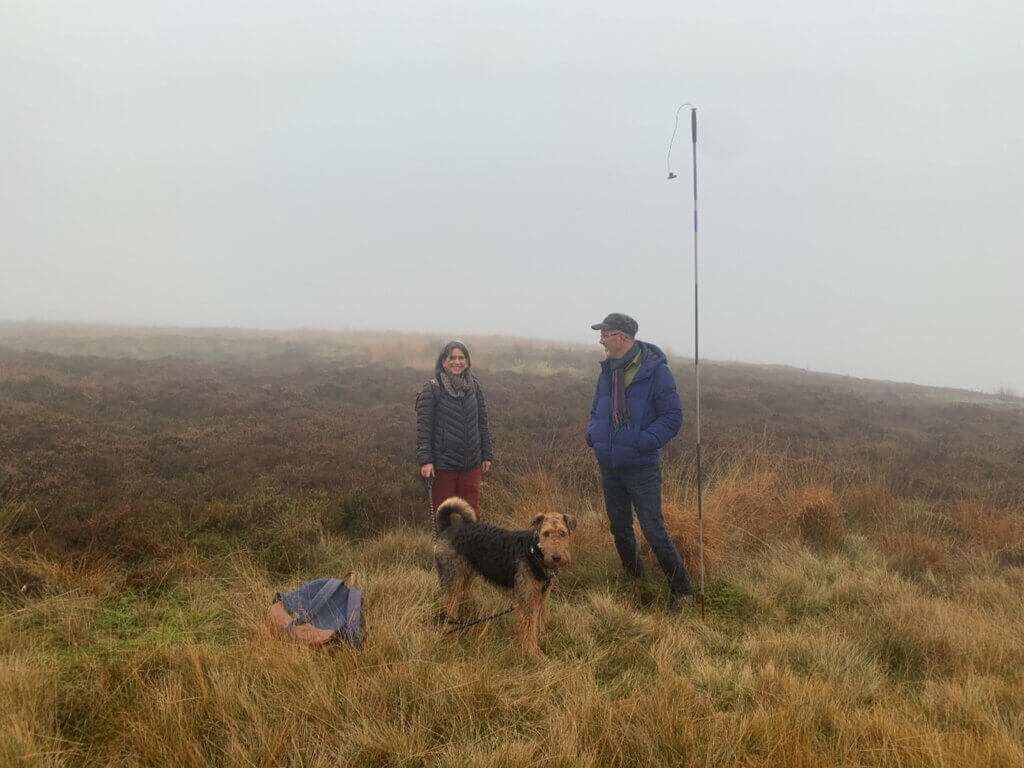
“The wind farm access track will come along this plateau from the main road. My ambition today is to work out how it will get down to T36, which is on an edge. Below it the ground steepens into the reservoirs.”
Eddy, who was bitten by a radioactive grouse when he was a teenager, wonders if the turbine blades will use the Pennine Way for access, which already seems a bit steep, and for the human half of the party has a coefficient of friction of μ = 0.002. “I think the track will come down on a slant from T41 and T36 will be a cul-de-sac.” An envious earworm forms in my brain. “Spiderprof, spiderprof, slippy slabs but he won’t slide off.” “Your blogs often seem like planning documents, as though you were trying to build the wind farm yourself!” Mariacarmen observes, somehow retaining poise like Jayne Torvill skating Ravel’s Bolero. “Like many people who live here, I thought the project was bonkers when I first saw it. The developer has no track record. One of the ways we prove this is by showing that we have thought more about Calderdale Wind Farm than the developers had in their scoping report and website FAQs, both of which we have shredded so that they are withdrawn.”
The path steepens at the edge, and we leave the Teflon-coated flagstones and work across some grim drainage. I am glad to note that Eddy has only lightweight boots, and am wondering maliciously just how wet his spideyfeet are when both of mine disappear into the swamp and I find out first hand. A flattening suggests we might be at a turbine site. Visibility is about 20m despite what the photograph shows. As we know from recent photographs of the aurora over Stanbury Moor, a phone gets more value out of light than the eye can. The avalanche probe only finds 60cm of peat and it should be more than 100cm, so we have not quite found the spot and must come back another day. Navigating by peat depth is like a Polynesian sailor using bird behaviour in the starless day. I’m meant to be checking the survey, not depending on it to find my location.
Four days later the fog clears, Ovenden Moor wind farm begins to stir, and with back bearings, the laminated OL21 and zero deviation between magnetic, grid and true north, the dog and I find a stake and a 110 cm of peat. As usual at a turbine site there is a distant view, which is a proxy for wind.
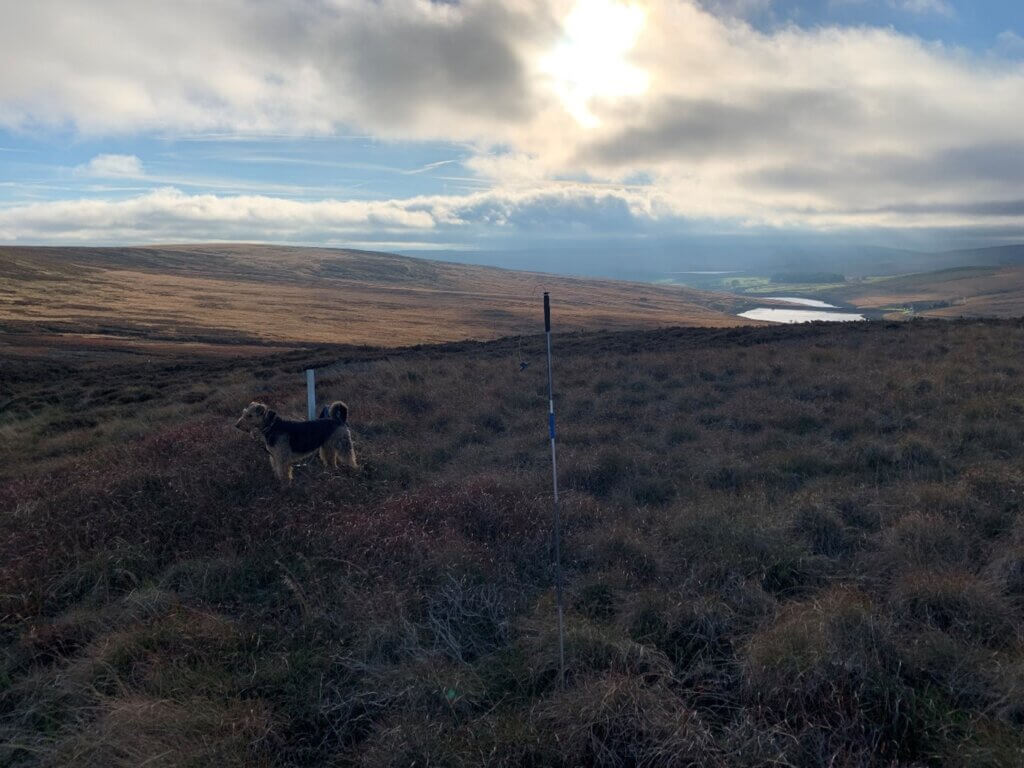
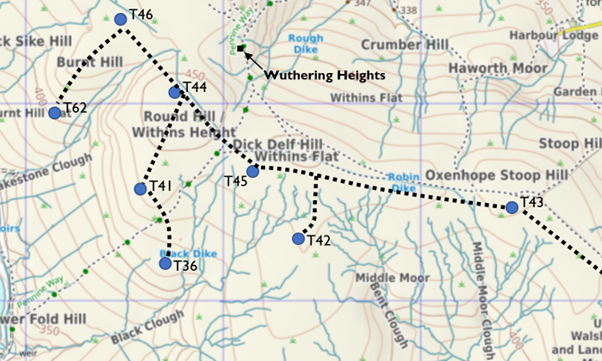
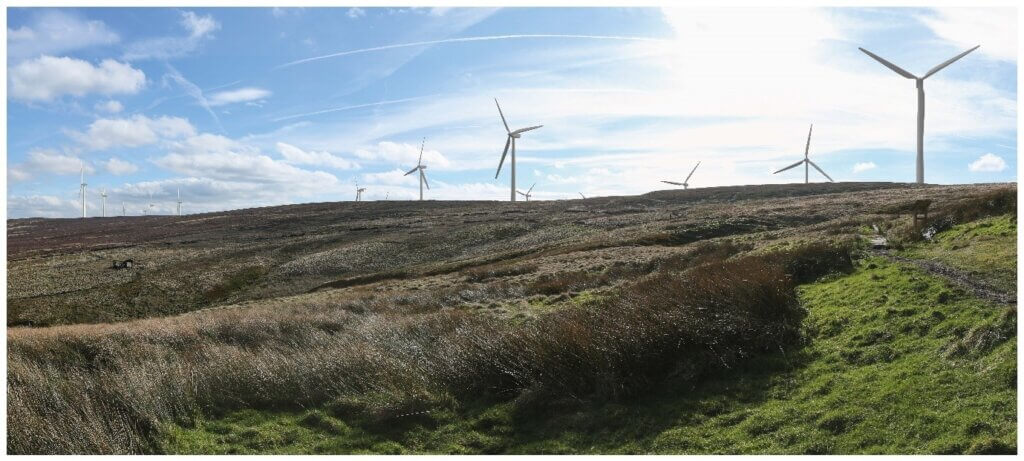
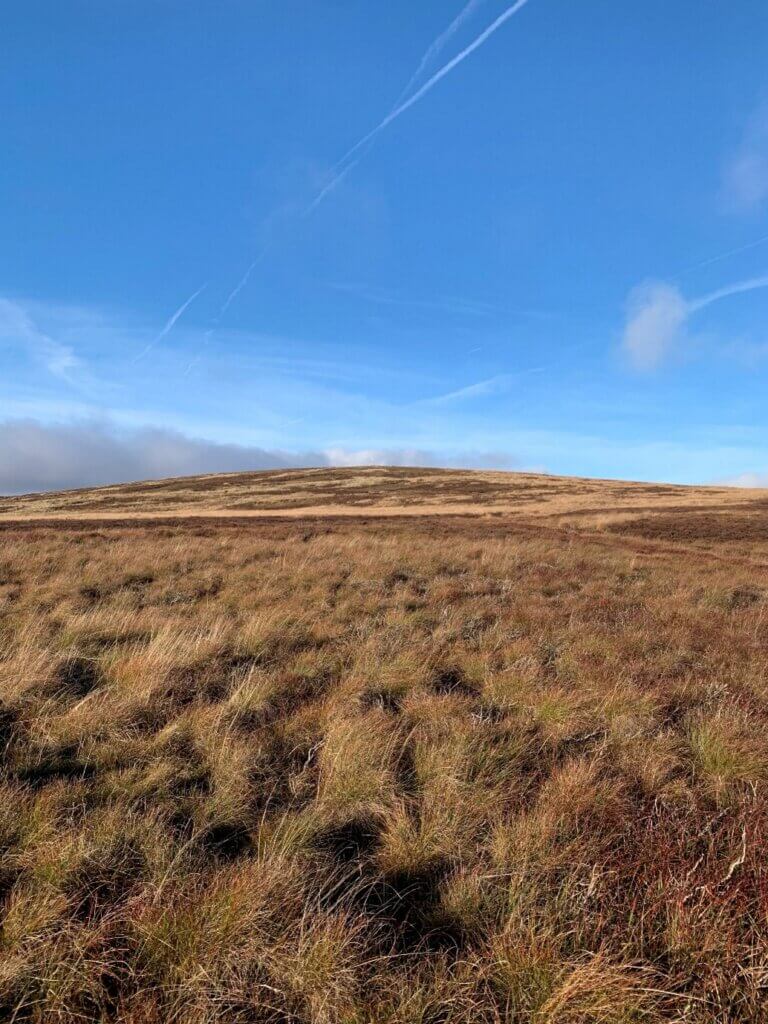
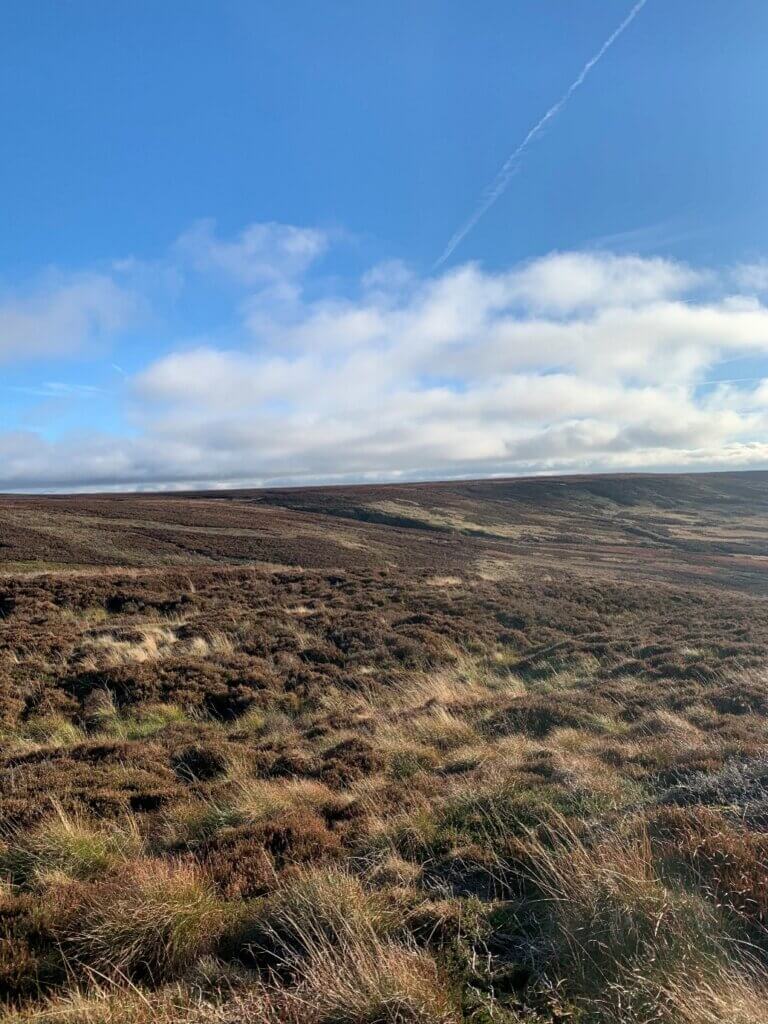
The peat survey suggests that the peat is shallow between the site and the Pennine Way, but it is over 200cm deep, and this is the first area of the survey which I have found to be very wrong. This is why I have come a third time, with the OS app to get my probe position right to the nearest metre. The dog and I walk toward T41 along the line of the access track and the peat deepens consistently to a maximum of 205cm, an orange depth, and remains full yellow to 160cm at the brink. The unmapped drainage is then a problem, with a big drop into a significant beck that is not on the 1:25000 map, beyond which is swamp down to the boulder clay. The dog jumps down and disappears. He should have brought his snorkel. I slide down on my bum and go in up to my thighs. This is horrible ground to walk over and will have to be completely excavated and filled with thousands of tons of imported limestone to make a culverted causeway over the swamp and a deep-filled trench beyond. Normally, peat of this depth would be crossed with a floating road, but the drainage is too unstable and once a floating road is viable, you are already at the dead end. Not a great deal of thought has gone into the layout of this illegal wind farm, and even if the Brontë Skyline is ruined, I don’t think T36 will be built in its cul-de-sac: the gross destruction of irreplaceable habitat will be too visible to walkers on the Pennine Way.
I only checked the survey here because it’s on my theorised line of the access track. The survey could have dozens of similar errors, and having found one, it is more likely there are many on the deepest peat: it is easy to survey the acid grazing with a short probe, or even an umbrella. Beyond dark green, it is hard work pulling the probe out again and again on a wet Friday evening somewhere near Burnley. The two youngsters who did the survey have my admiration.


Mariacarmen says that society should take a biocentric view of Walshaw Moor, and that the South Pennine SPA/SAC, its wildlife, its peat, and the services it gives to people should have the legal status of a human being. Readers interested in this idea, which is emerging as a way of thinking about the habitats on which humans also depend, might start with the Yarra River Act in Australia: “To provide for the declaration of the Yarra River and certain public land in its vicinity for the purpose of protecting it as one living and integrated natural entity.”
We might congratulate ourselves that in England we have already put the Pennine watershed beyond the greed of feudal landowners by designating it as a Special Protection Area and Special Area of Conservation. The Kunming-Montreal protocol has a ‘30×30 target’ in its Global Biodiversity Framework, an ambitious commitment to conserve 30% of terrestrial, inland water, coastal and marine areas by 2030, “through ecologically representative, well-connected and equitably governed systems of protected areas and other effective area-based conservation measures, recognizing indigenous and traditional territories.” England is terribly nature depleted, but Defra hoped when we signed in 2023 that the vast SPA and SAC network on the Pennine watershed would get us to our 30%. Christopher Wilson is gambling that Ed Miliband and the Labour Government (the Labour Government!) will deregulate the Pennine watershed so that the plutocrat families, feudal and late-capitalist alike, can exploit one living and integrated natural entity for private gain.
Labour Party members, if not yet their MPs, are doing what they can to stop this, and I am increasingly sure they will succeed. Below is the official position of the Keighley & Ilkley CLP. Their previous chair Pam Johnson spoke at the packed Haworth meeting to which Mark Avery so generously came, and she got off a memorable phrase: “This isn’t renewable energy. This is venture capital and a millionaire landowner.” Following the Haworth meeting, Lydia and I were invited to speak to Keighley Labour in December. We have done many such meetings but never with such an engaged audience, and we were thrilled by the response. When you campaign, you make a net as big as possible, and you cannot know who you will catch in it. Ed Miliband doesn’t read this blog, even though Christopher Wilson’s gopher does (Hi Muttley!) but this resolution from the CLP will get closer to the Secretary of State for Energy Security and Net Zero than I can.
Keighley and Ilkley CLP supports the Labour Government’s drive for renewable energy and welcomes the lifting of the moratorium on the building of onshore wind farms. The CLP also welcomes the Labour Government’s recent consultation on the National Policy Planning Framework which includes a chapter on “Supporting Green Energy and the Environment’. This asked a key question on habitats containing peat soils being considered unsuitable for renewable energy development due to their role in carbon sequestration and whether these should have additional protections or compensatory mechanisms put in place. The CLP also welcomes Keighley TUC’s decision to oppose the building of a 65 turbine Calderdale Windfarm on Walshaw Moor above Haworth and Oxenhope.
This branch notes that:
a] Although no formal application has yet been submitted, work on developing the proposal for Calderdale Windfarm continues and is likely to be considered as a ‘nationally significant infrastructure project’ (NSIP). Under the Planning Act 2008, this requires development consent from the relevant Secretary of State rather than the local planning authority
b] Friends of the Earth in association with Exeter University have identified several sites in this region that are suitable for the development of wind farms and that Walshaw moor is not one of them
c] Granting permission for a windfarm of this protected environment would set a significant precedent for other environmentally vulnerable sites
This CLP agrees that:
A] There should be additional protections and that where peat bog environment is extensive there should be a presumption against using such a site
B] Places of special value to wildlife, such as SACs (Special Areas of Conservation), SPAs (Special Protection Areas) and SSSIs (Sites of Special Scientific Interest) should be fully protected from development and be scoped out of development for renewable energy at an early stage
C] The building of the proposed Calderdale Windfarm would cause large scale and catastrophic damage to the peat bog environment and the designated SAC, SPA and SSSI on Walshaw Moor D. the building of Calderdale Windfarm will cause environmental damage to the surrounding area during construction and as a result of the depletion of the peat bog. For example, an estimated 900,000 tonnes of aggregate will need to be transported by road to the site from North Yorkshire through Keighley and the villages of Oxenhope and Haworth.
This CLP agrees to:
1] oppose the development proposals for Calderdale Windfarm
2] support the drive for clean energy while protecting delicate habitats and environments
Martyn Oliver, Chair of Keighley & Ilkley Labour Party.
Robbie Moore, the Conservative MP for Keighley and Ilkley, and Shadow Defra Minister also opposes CWF. “The other five constituencies around Walshaw Moor have new MPs. I remember being new, and it is only natural that they are perhaps a bit quiet for now, since it might seem they are challenging what might emerge as party policy to build on Special Protection Areas, but they will find their courage and I’m sure their constituents will support them.”
++++++++++++++++++++++++++++++++++++++++++
This is the 28th in a series of 65 guest blogs on each of the wind turbines which Richard Bannister plans to have erected on Walshaw Moor. Turbines 5, 6, 8, 9, 11, 16, 17, 21, 25, 27, 32, 33, 34, 35, 37, 40, 43, 44, 47, 53, 54, 56, 58, 62, 64 and 65 have already been described. To see all the blogs – click here.
[registration_form]
National news
https://www.bbc.co.uk/news/articles/c863dwl0xplo